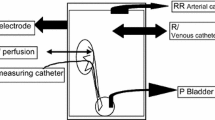Summary
The effect of distension on adrenergic innervation was investigated in the rat urinary bladder. Bladders were distended for 3 h by forced diuresis and ballon obstruction, and specimens were taken from the bladder dome, body and neck for the demonstration of glyoxylic acid-induced fluorescence of catecholamines. Depletion of catecholamines started after 10 h and was almost complete after 2 days. The fluorescence had recovered part way after 5–7 days and was practically normal after 21 days. Small, intensely fluorescent (SIF) cells in the ganglia continued to leak catecholamines throughout the 21-day study period. The primary clinical success of distension therapy for the treatment of unstable bladder may be at least partly due to a reversible disturbance in the function of the adrenergic nerves, which have an excitatory alpha-adrenergic dominance in such cases, but the persistent leakage from SIF cells raises the question of whether distension causes prolonged disturbances in bladder function.
Similar content being viewed by others
References
Andersson K-E (1986) Clinical relevance of some findings in neuro-anatomy and neurophysiology of the lower urinary tract. Clin Sci 70 [Suppl 14]:21s
Andersson K-E, Sjögren C (1982) Aspects of physiology and pharmacology of the bladder and urethral.Prog Neurobiol 19:71
Corrodi H, Johnsson G (1967) The formaldehyde fluorescence method for the histochemical demonstration of biogenic monoamines. A review on the methodology. J Histochem Cytochem 15:65
de Groat WC, Saum WR (1972) Sympathetic inhibition of the urinary bladder and of pelvic ganglionic transmission in the cat. J Physiol 220:297
Dunn M, Smith JC, Ardran GM (1974) Prolonged bladder distension as a treatment of urgency and urge incontinence. Br J Urol 46:645
Ek A, Alm P, Andersson K-E,Persson CGA (1977) Adrenergic and cholinergic nerves of the human urethra and urinary bladder. A histochemical study. Acta Physiol Scand 99:345
Elbadawi A (1982) Neuromorphologic basis of vesicourethral function: I. Histochemistry, ultrastructure and function of intrinsic nerves of the bladder and urethra. Neurourol Urodyn 1:3
Eränkö O (1955) Distribution of fluorescing islets, adrenalin and non-adrenalin in the adrenal medulla of the hamster. Acta Endocrinol 18:174
Eränkö O (1967) The practical histochemical demonstration of catecholamines by formaldehyde-induced fluorescence. J R Microsc Soc 87:259
Gosling JA, Chilton CP (1984) The anatomy of the bladder, urethra and pelvic floor. In: Mundy AR, Stephenson TP, Wein AJ (eds) Urodynamics Principles, practice and application. Churchill Livingstone, Edinburgh, p 3
Jonsson G (1967) The formaldehyde fluorescence method for histochemical demonstration of biogenic monoamines. Thesis, Stockholm
Jörgensen L, Mortensen SO, Colstrup H, Andersen JT (1985) Bladder distension in the management of detrusor instability. Scand J Urol Nephrol 19:101
Kyösola K, Waris T, Penttilä O, Ahonen A, Penttilä A, Mattila T, Järvinen A (1985) Multi-score estimation of catecholamine fluorescence for clinical purposes. Acta Histochem 76:65
Lindvall O, Björklund A (1974) The glyoxylic acid fluorescence histochemical method: a detailed account of the methodology for the visualization of central catecholamine neurons. Histochemistry 39:97
Mundy AR (1984) Clinical physiology of the bladder, urethra and pelvic floor. In: Mundy AR, Stephenson TP, Wein AJ (eds) Urodynamics, Principles, practice and application. Churchill Livingstone, Edinburgh, p 14
Norlen L (1976) The autonomous bladder. A clinical and experimental study. Scand J Urol Nephrol Suppl 36:1
Papka RE, Traurig HH, Klenn P (1987) Paracervical ganglia of the female rat: histochemistry and immunohistochemistry of neurons, SIF cells, and nerve terminals. Am J Anat 179:243
Restorick JM, Mundy AR (1989) The density of cholinergic and alpha and beta adrenergic receptors in the normal and hyperreflexic human detrusor. BR J Urol 63:32
Tammela T, Kontturi M, Lukkarinen O (1986) Postoperative urinary retention: II. Micturition problems after the first catheterization. Scand J Urol Nephrol 20:257
Waris T, Partanen S (1975) Demonstration of catecholamines in peripheral adrenergic nerves in stretch preparations with fluorescence induced by aqueous solution of glyoxylic acid. Histochemistry 41:369
Waris T, Liesi P,Panula P, Partanen S (1982) The resistance of glyoxylic acid induced catecholamine fluorescence to sodium borohydride reduction. Acta Histochem 71:161
Author information
Authors and Affiliations
Rights and permissions
About this article
Cite this article
Tammela, T., Lasanen, L. & Waris, T. Effect of distension on adrenergic innervation of the rat urinary bladder. Urol. Res. 18, 345–348 (1990). https://doi.org/10.1007/BF00300785
Accepted:
Issue Date:
DOI: https://doi.org/10.1007/BF00300785




